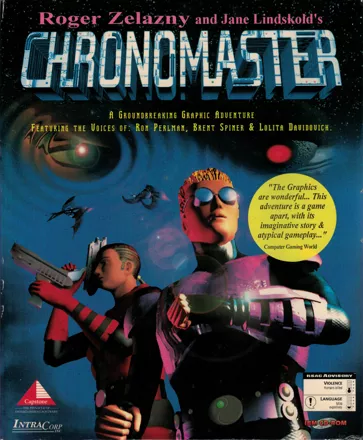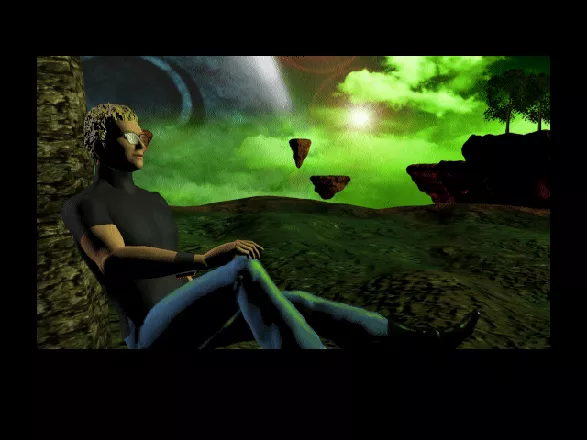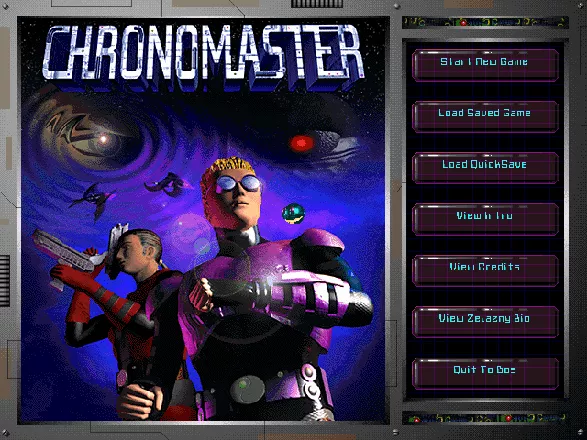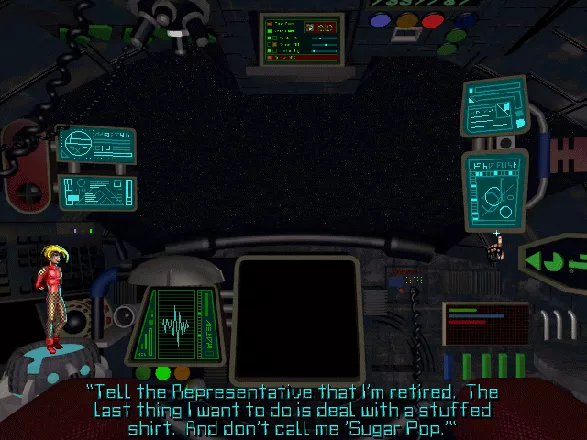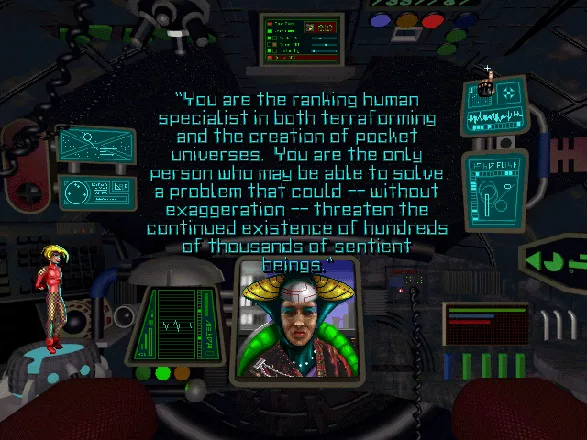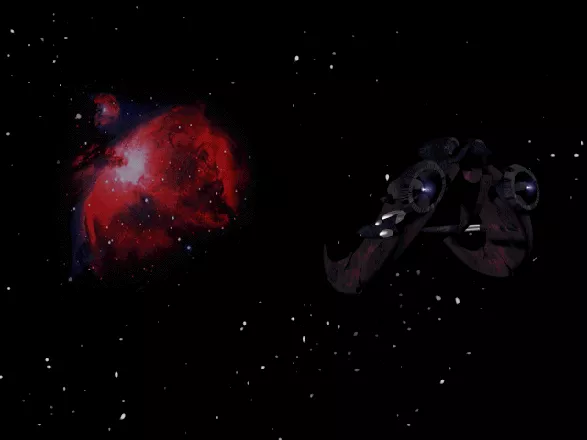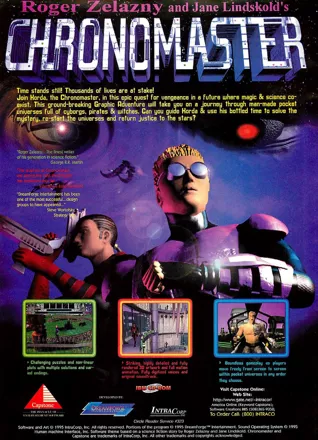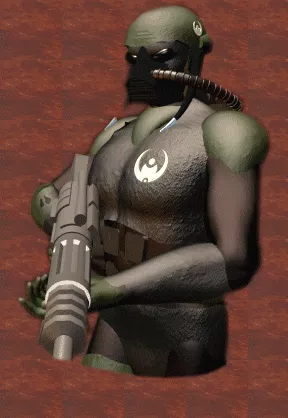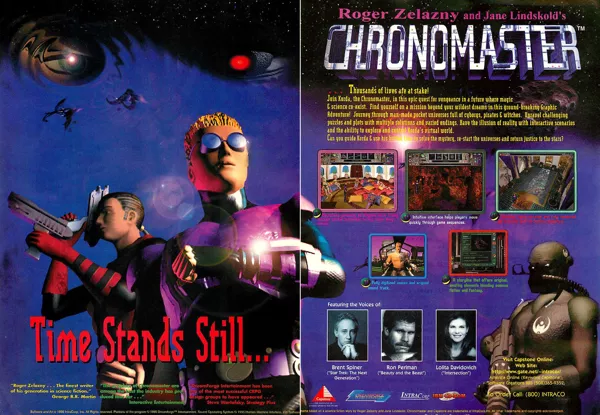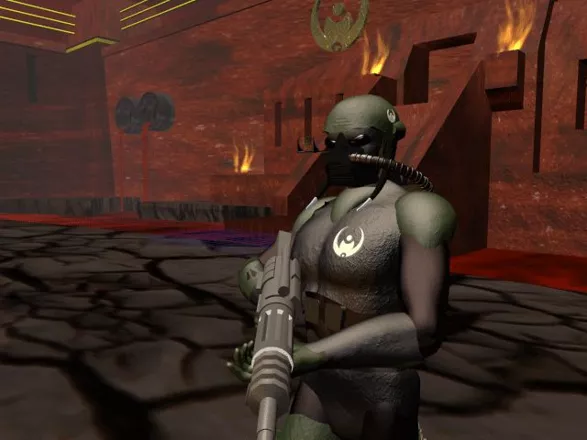Chronomaster
Description official descriptions
Chronomaster is an adventure game, written by two famous science fiction authors, Roger Zelazny and Jane Lindskold.
It takes place in a future where universe creation has been taken to an art form with the advent of Pocket Universes (a concept introduced in this game by Zelazny). In the game you play the role of Rene Korda, one of the most respected creators of Pocket Universes in the galaxy. The Terrn Regional Government asks you to intervene when five Pocket Universes are put to stasis by an unknown force.
Screenshots
Promos
Credits (DOS version)
60 People · View all
| Lead Design | |
| Engine Design | |
| Programming | |
| Graphics / Artwork | |
| 3D Modelling | |
| Music | |
| [ full credits ] | |
Reviews
Critics
Average score: 73% (based on 18 ratings)
Players
Average score: 3.8 out of 5 (based on 23 ratings with 4 reviews)
One of the best quest games I've ever played.
The Good
Simply marvellous. Wonderful storyline, great graphics and decent music and animations. An incredibly twisted, surreal universe. Also happens to be one of the most challenging games I've ever played.
Also wonderful actors and voice impersonation.
The Bad
There are some really stupid scenes in the game, and the animations are slightly on the amateurish side, but it's otherwise wonderful.
The Bottom Line
One of the best games you'll ever play.
DOS · by Tomer Gabel (4534) · 1999
I felt like Alice in science fiction Wonderland
The Good
Chronomaster is a point-and-click adventure game which tries to mix science fiction with fairy tales. The result has all the weirdness of an “Outer Limits” episode.
Six unique planetary systems make up the “pocket” universes, all frozen in time “stasis” by an unknown perpetrator. Some of the planets are truly bizarre while others are more realistic. There are a myriad of characters including unicorns, plants that talk, pigs that fly, witches, sprites, belly dancers, soldiers, gamblers and more.
The game appears to be aimed at the science fiction audience, and it starts out that way (on a space ship with all sorts of gadgets and gizmos at your disposal), but it turns out to be more whimsical fantasy than the purist sci-fi fan might like. Although set in the future, the planetary worlds you visit were created with altered physics, making magic possible. This lends itself to creative imagination, often to the extreme.
Your quest is to restore each world to normality, such that it is, by locating its “world key” and positioning it on the planet’s “magnetic north” with the aid of a “resonance tracer”. Nothing can be transferred between the worlds and your adventure is confined to that location once you land upon it. You are able to move about freely, even though everything else is still, because of the “bottled time” you carry with you and surrounds you as you explore. Walking too closely to a frozen person or object can release it, sometimes causing unexpected results, so you need to be on your toes all the time.
With a little practice, I was comfortable with the interface after only a few minutes. Action icons for look, talk, open, take, use etc. appear on the menu bar at the top of the screen, but also can be accessed by a right mouse click. A right click also lets you scroll through your object inventory, which can become quite large as you progress.
The locations are richly detailed and visually interesting and there are various types of puzzles to solve, some on the hard side. You’ll find numerous conversation-based puzzles (i.e., help him and he’ll help you), one of the most annoying mazes I’ve ever seen, plus other traditional puzzle types. Some of the puzzles can be considered really imaginative, while others are just obstacles in your path.
The game has several possible endings depending upon actions you have (or have not) taken. In most instances you can choose to act aggressively or peacefully to solve the same situation, and each has its own advantages and disadvantages. Many times you will die because you chose the wrong conversation option.
The Bad
Besides the obnoxious maze, there are a few other things I didn’t like about Chronomaster.
Although graphical atmosphere is really good and interesting, the characters themselves are stiff and unlifelike. Korda’s purple suit and jerky, puppet-like movements didn’t endear me to him in the least. And he walked so painfully slow sometimes that I wished I could figure out a way to make him run! There is quite a lot of dialog to read and listen to, but it was written badly with improper grammar and spoken badly without emotion or appropriate inflections. I agree with another reviewer who said that the voice of Ron Perlman made the main character sound “as though he would rather be somewhere else.”
I honestly didn’t mind dying (and I did, often!) but wished I could have been warned. I learned to save..save..save.
The Bottom Line
As adventure games go, this one is only fair. The alternative puzzle solutions and varied endings were not enough to make me want to replay it. Blending futuristic technology with fairy tales made the gaming experience strange. Some parts were wonderfully done, while others were so abstract that I almost threw it in the trash. It is not the worst game I’ve ever played – but it comes close.
DOS · by Jeanne (75814) · 2002
A real, exceptionally interesting intreractive novel.
The Good
The plot, wriiten by acclaimed science fiction writer Roger Zelazny and Jane Lindskold, is non linear, and there is always more than one way to solve a problem, yet still appealing and satisfying. You will sometimes have to decide what you consider morally correct, and act accordingly. There are three ending sequences to the game, according to the actions you took during the game.
The graphics were considered very good at the time, and is still very beautiful and imagentive today, even if a bit simple on the technical side.
The music adds much to the general atmosphere, and is varied, ranging from haunting, atmospheric music to rythmical, exotic music - all fitting with the setting if the game.
The puzzles are challenging and varied, from word puzzles and numerical puzzles to mazes and lateral thinking puzzles.
The Bad
The interface is somewhat tiring, since not all the commands can be accessed by right clicking.
There are insanely difficult puzzles, such as the crazy world of Verdri, where ice burns, bees talk, pigs fly and nothing is what it seems.
The Bottom Line
A clever game, which is not only fun but provokes thinking.
DOS · by Mickey Gabel (332) · 2000
Trivia
Development
Capstone Software did the voices for this game, and they also came up with the idea for the game before they contacted DreamForge.
Sounds
While in the game (as in playing on one of the worlds) press the F- keys (as in F1, F2, F3, etc.). You get different sounds for each of them.
Information also contributed by Shadow Weaver
Analytics
Related Sites +
-
Chronomaster Hints
Chronomaster Hints to help you solve the game -
Darksheer's Walkthrough
Fairly comprehensive walkthrough for Chronomaster -
Roger Zelazny Fan Site
Many links to Chronomaster info. Reviews, Hints, Walkthroughs and more.
Identifiers +
Contribute
Are you familiar with this game? Help document and preserve this entry in video game history! If your contribution is approved, you will earn points and be credited as a contributor.
Contributors to this Entry
Game added by Tomer Gabel.
Windows, Macintosh added by Rik Hideto. Linux added by Iggi.
Additional contributors: Jony Shahar, Jeanne, Patrick Bregger.
Game added August 25, 1999. Last modified August 2, 2024.


